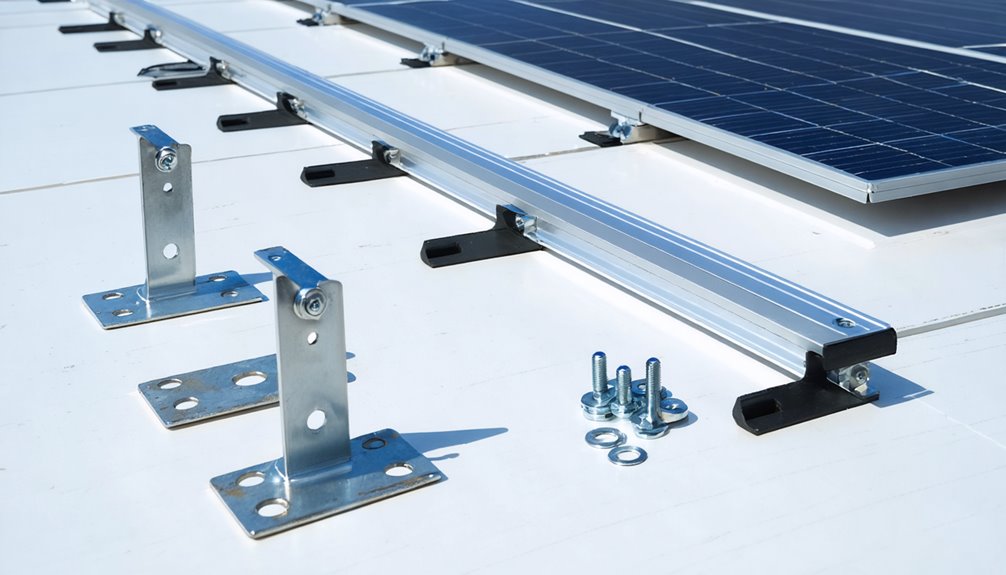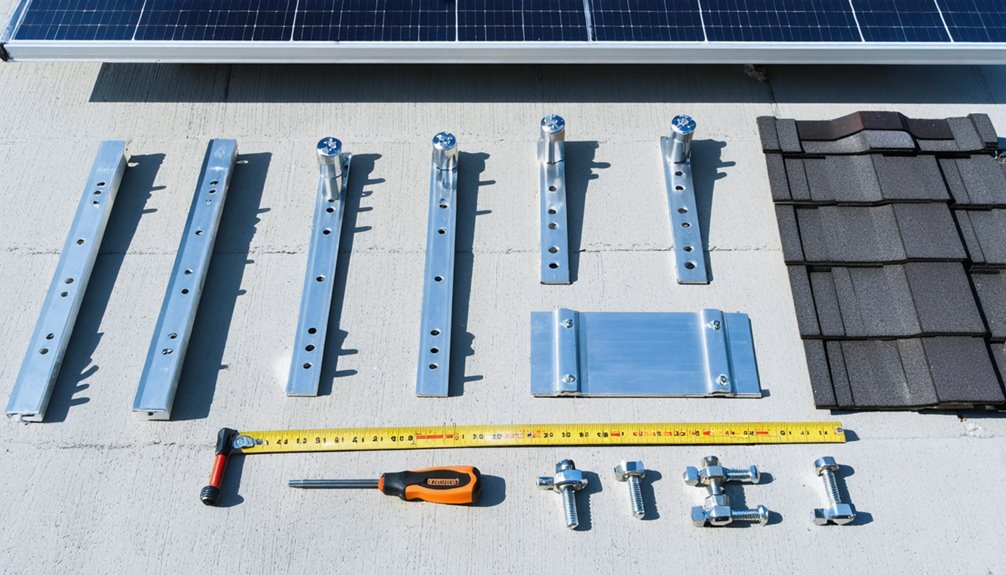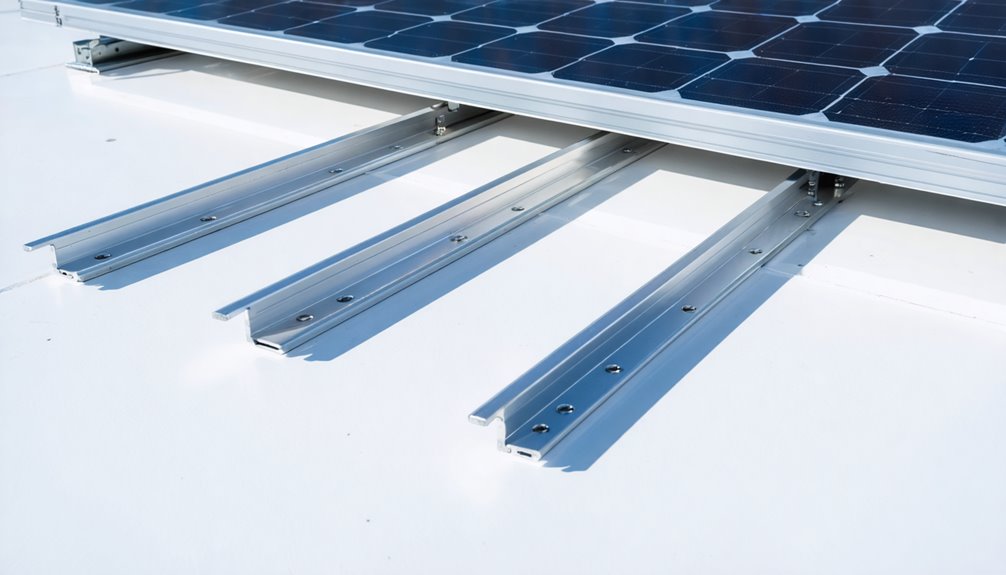You’re investing thousands in solar panels, but what holds them in place matters just as much. The mounting brackets you choose can mean the difference between decades of reliable energy or costly repairs. Industry leaders like IronRidge and Unirac dominate the market, but newer competitors offer innovative solutions at lower prices. With options for every roof type and budget, finding the right brackets isn’t simple—and making the wrong choice could prove expensive.
Types of Solar Panel Mounting Brackets and Their Applications

Anyone looking to install solar panels needs to choose the right mounting bracket for their specific situation. You’ll find several solar mounting systems available today. Roof mounts attach directly to your home’s roof and work with different materials. They don’t need extra ground space. Ground mounts use metal frames at ground level for larger solar panel installation projects. You’ll get easier maintenance access with these systems. Pole mounts work well in remote areas where you can’t use roof space. They’ll optimize energy production through adjustable angles. These systems offer enhanced adjustability that allows panels to track the sun’s movement throughout the day for maximum exposure. Adjustable mounting brackets let you change panel positions to maximize solar exposure. Each type helps secure solar panels differently. Your installation process depends on which bracket you choose for maximum solar energy collection.
Key Features to Consider When Selecting Mounting Brackets
Choosing the right mounting bracket features can make or break your solar panel system’s performance. You’ll need roof attachments that match your specific roof type. Solar panel mounts come designed for asphalt, metal, tile, and flat roofs to guarantee secure installation.
Safety matters in solar installation. That’s why you’ll find brackets with UL 2703 certification. This certification means they’ve met industry standards for safety and performance.
Adjustable brackets let you change the tilt and angle of your panels. This flexibility helps maximize energy production based on your location.
Durability and material choices affect longevity. Galvanized steel and aluminum brackets resist weather and corrosion better than other materials.
Installation ease varies between systems. Some mounting brackets don’t require welding or drilling, which speeds up the setup process. For flat roof installations, ballast mount systems provide a non-penetrating solution that uses weighted blocks to secure panels without compromising the roof membrane.
Top Mounting Bracket Brands and Product Comparisons
When you’re shopping for solar panel mounting brackets, you’ll find IronRidge and Unirac lead the market with proven track records. IronRidge’s XR rail series works best for pitched roofs. These durable solar mounting systems provide strong support for solar panel installations.
Unirac specializes in flat roofs with adjustable tilts. You can change the angles to match your installation conditions. Both brands meet industry standards and offer innovative mounting solutions.
You’ll discover these companies sell individual components for DIY installations. They also provide complete solar panel kits. The mounting brackets work with various solar panels.
Beyond roof installations, these manufacturers produce specialized brackets for ground and pole mounting configurations that suit different property layouts and energy requirements.
Manufacturers recommend checking specifications before buying. Licensed installers can help determine which system fits your needs. Both IronRidge and Unirac maintain strong reputations without major product weaknesses.
Installation Requirements and Compatibility Factors

Before you install solar panel mounting brackets, you’ll need to match them with your specific roof type. Different materials like asphalt, metal, tile, or flat surfaces have unique installation requirements. You’ll also need to check weight distribution needs. Some roofs require extra support like standoffs.
| Roof Type | Special Requirements | Support Needs |
|---|---|---|
| Asphalt | Standard brackets | Basic setup |
| Metal | Clamps or rails | Minimal extra |
| Tile | Hook systems | Standoffs |
| Flat | Ballasted frames | Heavy-duty |
Your mounting brackets must satisfy local building codes for wind and snow loads. Modern mounting systems undergo rigorous wind and snow load testing to ensure they meet reliability standards in various weather conditions. Adjustable brackets work well on uneven surfaces or areas with changing sunlight. Licensed installers guarantee proper compliance with safety standards and durability standards. They’ll handle the technical aspects correctly.
Cost Analysis and Long-Term Value Considerations
Solar mounting brackets represent a significant investment in your system’s total cost. You’ll typically spend $330.75 to $603.80 on these essential components. Your installation budget must account for racking solutions, which make up about 10% of your solar installation cost. That’s roughly $1,000 in a $10,000 system.
Quality solar mounting brackets offer excellent long-term value through their durability. They’ll reduce your maintenance costs over time. These brackets also boost your energy production efficiency, leading to lower utility bills. Your return on investment speeds up when you choose reliable mounting systems. Ground-mounted systems provide optimal tilt angles that maximize energy production throughout the year, further enhancing your financial returns.
Research shows solar installations increase property value by 6.9% on average. That’s a substantial benefit when you sell your home. The initial cost analysis might seem high, but the financial rewards extend far beyond energy savings.
Conclusion
You’ve learned about different mounting bracket types and their uses. You’ve discovered what features matter most when choosing brackets. You’ve seen how top brands like IronRidge and Unirac compare. You now understand installation requirements and compatibility needs. You’ve also reviewed the costs and long-term value of quality brackets. This information helps you make smart choices for your solar panel installation. The right brackets guarantee your system works efficiently for years to come.


